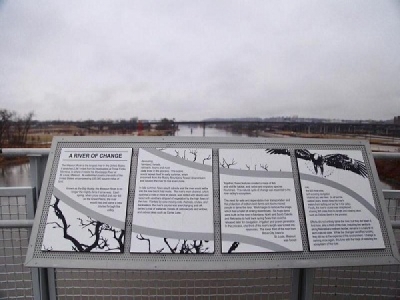
Posted on April 19, 2018
By Clay Masters, Iowa Public Radio
The Missouri River has seen several devastating floods in the past decade. Now, a federal judge says the U.S. Army Corps of Engineers is responsible for potentially hundreds of millions of dollars worth of property damage over how it handled some of these floods. The ruling has intensified a debate about how best to manage the river that runs from Montana to Missouri.
A sign on the Bob Kerrey Pedestrian Bridge over the Missouri River between Council Bluffs, Iowa and Omaha, Nebraska calls the Big Muddy “forever changed by the power of humans.”
Decades ago, directed by Congress, the Army Corps of Engineers constructed a system of dams and reservoirs to accommodate more barge traffic and allow people to develop land in the natural floodplain. But it also destroyed habitat for some wildlife.
“The Missouri River is the longest river in the United States and it is also the most highly modified,” says Marian Maas with the Nebraska Wildlife Federation.
Maas and others say turning that land into natural floodplain would reduce the potential for flood damage.
“There is great holding capacity in backwaters,” Maas says.
But there are a lot of people who live and farm along the river who don’t want to lose their land.
In 2004, things changed. The Army Corps changed how it managed the river, making habitat for endangered species, specifically two birds and a fish, more of a priority than flood control.
“Flood control was no longer the dominant function of the management of the river,” says Sidney, Iowa-area farmer Leo Ettleman. “The flood control constraints got changed and we saw immediate negative impacts.”
So, Ettleman and hundreds of other farmers and business owners along the river sued the Army Corps of Engineers. They allege the actions contributed to five floods along the river since 2007.
The Corps had notched dikes and reopened historic chutes to allow more water to flow and restore habitat. But the judge ruled this allowed the river to meander and erode the bank, which contributed to devastating floods.
“I am very encouraged by this ruling and I do hope the Army Corps uses this an opportunity to go back, review and correct the problematic policies they have in the past,” says U.S. Senator Joni Ernst (R-Iowa).
Ernst was a member of the National Guard and assisted with recovery efforts during the massive flood of 2011. A spokesman for the Corps says they can’t comment because the litigation is not over, but it will continue to enforce the laws of the land.
“There would be significantly less damage if there had been places for the water to go,” says Brad Walker who recently retired as the Executive Director of Missouri River Coalition for the Environment.
Walker says the judge’s decision was misguided and the work that was being done to restore the natural floodplain would have helped flood control and landowners are partly to blame.
For now, the judge is determining the exact monetary damages from floods that have become common along this river forever changed by the power of humans.
Source: Iowa Public Radio





